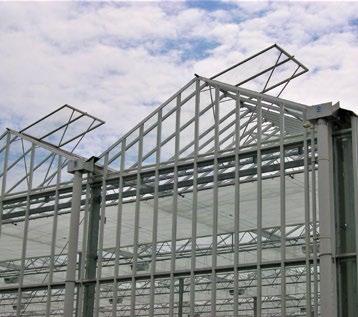
6 minute read
Mechanical ventilation in semi-closed glasshouses
Words by Elly Nederhoff : Crophouse Ltd
Roof vents wide open on a hot day
This series of articles is about improving energy efficiency in greenhouses, as part of the plan to reduce carbon (CO2) emissions, or ‘decarbonise.’
Greenhouse growers are encouraged to transition from carbon-emitting fuels such as coal, oil, and even natural gas, to low-carbon alternatives. Some low-carbon energy sources include sustainable electricity, biomass, biogas, waste heat, geothermal energy, and in the future, hydrogen. This article is about using ‘green’ electricity for greenhouse control. Electrification often starts with using electric fans for mechanical ventilation.
Electricity
Climate control based on electricity can only be sustainable if the electricity is generated by hydropower, wind, solar power, or other sustainable means. For decades, a large proportion of New Zealand’s electricity supply has been generated by hydropower stations. The demand for power has constantly increased and less hydropower is now being produced due to low water levels in lakes. The void is filled by power stations fired by conventional unsustainable fuels.
Electricity transmission over a long distance is inefficient and expensive. Ideally, power would be generated in close proximity to where it is needed, perhaps even on-site. Currently, there are insufficient incentives for installing solar systems or wind turbines, but once sustainable power becomes accessible and affordable, electrification of greenhouse climate control can become a viable option.
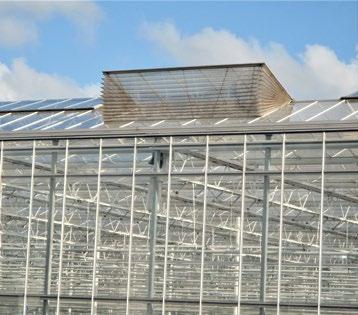
Fewer vents means less maintenance
Mechanical ventilation
The use of mechanical, or forced ventilation, to replace (or supplement) natural ventilation requires a system of axial fans with air tubes (sleeves, hoses) called Air Treatment Units (ATUs). A glasshouse with forced ventilation can have up to 75% fewer roof vents than a standard glasshouse. The less natural ventilation there is, the stronger the forced ventilation must be. Therefore, there is a wide variation in forced ventilation rate. Some systems can only exchange 5 m3 of air per m2 per hour – whereas others can achieve up to 80 m3 .
Semi-closed greenhouses
Greenhouses with forced ventilation and reduced natural ventilation are known as semi-closed greenhouses. There is a wide range of semi-closed systems available, some very advanced. Over nearly a decade, many semi-closed greenhouses have been built in Europe and elsewhere. Some have shown astonishing results, especially in regions with extreme climates.
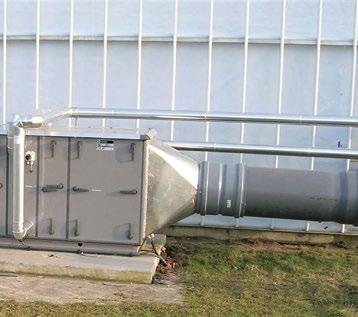
The greenhouse on the right has forced ventilation
Fan system design
Forced ventilation systems must be designed properly with regards to the spacing and dimension of the tubes (0.3-1 metre diameter), single or double skin tube, number and positioning of perforations, fan speeds and electrical capacity.
The axial fan must be powerful enough for the length of the tube connected to it and be able to run at variable speed. Depending on the design, fans often run at about 30–70% of full capacity, or in the order of 50% on average over a year.
The fans (Air Treatment Units) can be built along an outside greenhouse wall or can be installed inside a corridor. Here, the greenhouse air is mixed with outside air, and treated if required. Depending on local climate conditions, air treatment can be applied by built-in devices, for instance; a heating coil, cooling coil, pad-and-fan cooling (adiabatic cooling), energy recovery, condensation recovery, CO2 injection and fogging.
The figures
The tubes can be spaced out, for example, at two metres. A 100-metre-long tube then serves 200 m2 . An example of a small system is one with 60-metre-long tubes, each with a 350-Watt axial fan. Each fan can move about 6,000 m3 of air per hour, which is 50 m3/m2/hour. Assuming the fans run at 50%, the electricity capacity is only 1.5 Watt per m2 (350 x 0.5 x (1/120)). The annual power use can be estimated at 13 kiloWatt hour per m2 per year (1.5 * 365 * 24 * 0.001). This is equivalent to about 1.5 m3 gas/m2 per year but does not include heating.
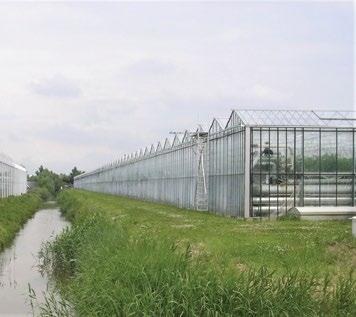
A fan for mechanical ventilation
Driving Crop Performance
Combines the effects of slow and fast release Magnesium Reduced leaching losses High utilisation rate




Make the right choice




Sustained Nitrogen availability with reduced leaching Improves root health, plant growth and crop quality Excellent nutrition

Here the fans are placed in a corridor (photo Enerdes)
For instance, a large system – one with very long tubes of 140 metres (covering 280 m2) – may have a strong axial fan of 2.6 or even 3.5 kiloWatts. Each fan can move 18,000–22,000 m3 per hour, or 64–79 m3/m2/hour. If a fan runs at 50%, it uses 4.6–6.3 Watt per m2. Over a whole year, at 50% on average, the power use would be 41–55 kWh/m2/year. This is equivalent to roughly 4.7–6.3 m3 natural gas per m2 per year.
Special thanks to Frank Van Rooijen (www.reinderscorporation.com/enerdes) for providing these technical figures.
Advantages
The advantage of a semi-closed greenhouse is that there are fewer vents, therefore less wear and tear and maintenance. Fewer vents also mean less light is lost and insect ingresses are reduced. The advantages of forced ventilation over natural ventilation are better controllability, better temperature, and humidity distribution – hence less condensation, a lesser risk of fungal infection, and possibly a higher CO2 level at the same CO2 injection rate. Due to better humidity control, the humidity setpoint can be selected to be higher without increasing the risk of plant disease. This reduces the amount of energy needed for humidity control. Forced ventilation can also be used to influence plant transpiration. When the fans remove moisture, the plants will respond by increasing transpiration. In greenhouses with a thermal screen, forced ventilation prevents moisture build-up under the screen. Hence there is no need for a gap in the screen for humidity control, which saves energy. Forced ventilation helps to improve the energy efficiency in several ways, particularly through more efficient humidity control.
Complications
Both with natural and forced ventilation, not much can be done when the conditions inside and outside are nearly the same. The fans are then set to a high speed, so the air movement has some effect. The fan speed is often controlled based on the difference in absolute humidity between inside and outside.
Most of the time the fans don’t need to run at their maximum speed. But if they run too slowly, poor air distribution can occur, and the tubes can collapse due to insufficient pressure. The grower will need to find the right balance between energy use and keeping the tubes inflated.
Providing additional heating through the tubes does not always work, depending on many variables. Warm air in a tube cools down much faster than hot water cools down in a heating pipe. In those systems it works best if the incoming fresh air is pre-heated to the temperature of the greenhouse air and not much higher.
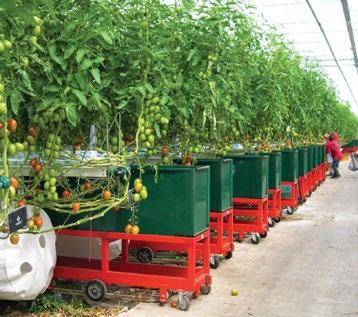
Air tubes in one of the first semi-closed greenhouses
Conclusions
Semi-closed glasshouses with mechanical (forced) ventilation are currently being used successfully in many locations around the world. Forced ventilation gives greater controllability, improves humidity control, indirectly saves energy, and increases the efficiency of CO2 enrichment.
PRODUCT GROUPS
ALL THE LATEST NEWS FROM YOUR PRODUCT GROUPS
56 POTATO SEED CO-OP











